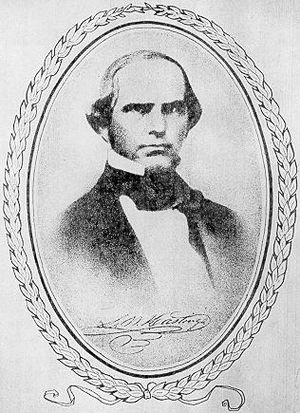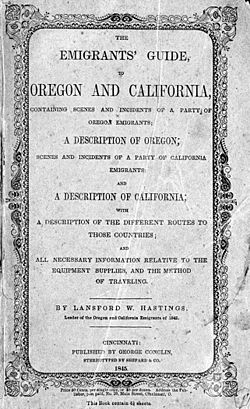Lansford Hastings facts for kids
Quick facts for kids
Lansford Hastings
|
|
|---|---|
 |
|
| Born |
Lansford Warren Hastings
1819 Mount Vernon, Ohio
|
| Died | 1870 (aged 51) St. Thomas, Virgin Islands
|
| Occupation | lawyer, writer and adventurer |
| Known for | developer of the Hastings Cutoff |
| Spouse(s) | Charlotte Toler |
Lansford Warren Hastings (1819–1870) was an American explorer and soldier. He is best known for creating the Hastings Cutoff. This was a supposed shortcut to California across what is now Utah. Sadly, this route played a part in the famous Donner Party disaster of 1846. Hastings also served as a Major in the Confederate States Army during the American Civil War.
Early Life and Dreams
Lansford Hastings was born in Mount Vernon, Ohio. His parents were Dr. Waitstill and Lucinda (Wood) Hastings. He studied to become a lawyer. In 1842, he traveled west to Oregon. While there, he helped Dr. John McLoughlin with his land claims. He also surveyed Oregon City, Oregon, which became the first city west of the Rocky Mountains.
In 1843, Hastings moved to Alta California. At that time, California was a part of Mexico. When he returned to the United States in 1844, he had a big idea. He wanted to help California become an independent country, separate from Mexico. He hoped to hold an important position in this new "Republic of California."
The California Shortcut Guide
To make his dream happen, Hastings wrote a book called The Emigrants' Guide to Oregon and California. He wanted to encourage many Americans to move to California. He hoped that if enough Americans moved there, they could take over without a fight.
In his book, Hastings described California in very positive ways. He also gave advice to people traveling overland. He suggested a "most direct path" that would leave the main Oregon route. This path would go to the Salt Lake and then continue to the San Francisco Bay.
However, Hastings wrote this before he had actually traveled the entire route himself. He did not know how difficult it would be to cross the Wasatch Mountains and the Bonneville Salt Flats in western Utah. His first trip on part of the route was in good weather. He had plenty of time and did not try to cross the desert section.
Even so, he quickly told everyone that his new route was faster and better. Because of his reputation as a writer and trail leader, many travelers believed him. This included the Donner Party, who decided to take the shortcut that now carries Hastings's name.
Hastings's dream of an independent California ended soon after. The United States military conquered California during the Mexican–American War. In 1848, Mexico gave California to the United States under the Treaty of Guadalupe Hidalgo.
A home he owned in California, the Hastings Adobe, is now a historic landmark.
Later Years and New Adventures

After serving as a captain in the California Battalion during the Mexican–American War, Hastings went back to being a lawyer. In 1848, he married Charlotte Toler. He was also a delegate at the 1849 California Constitutional Convention.
In the late 1850s, Hastings moved his family to Yuma, Arizona. There, he worked as a postmaster and a judge. During the American Civil War, Hastings supported the South. In 1864, he traveled to Richmond, Virginia. He met with Confederate President Jefferson Davis. Hastings wanted support for a plan to separate California from the Union and join it with the Confederacy.
President Davis promoted Hastings to the rank of Major. He asked Hastings to gather a military unit in Arizona to defend California. However, this plan, sometimes called the "Hastings Plot," did not succeed. The war ended early the next year.
After the war, many former Confederates left the United States. Some went to establish colonies in Brazil. Hastings visited Brazil and made arrangements with the Brazilian government. He then wrote another book, The Emigrant's Guide to Brazil (1867), to attract new settlers.
Lansford Hastings died in 1870 in St. Thomas, U.S. Virgin Islands. He may have died from yellow fever. He was on a ship taking settlers to his colony in Santarém, Brazil.


